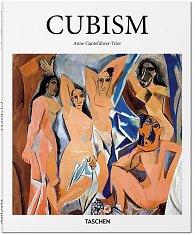
Cubism (ENG)
Anne Ganteführer-Trierová| Běžná cena: | 349 Kč |
| Sleva: | 10% |
| Dostupnost: | Nedostupné |
|---|---|
 Když teď objednám,
Když teď objednám, kdy zboží obdržím? |
|
| Kód: | D0301564 |
|---|---|
| EAN: | 9783836505390 |
| Nakladatel: | TASCHEN |
| Vazba: | Pevná s přebalem lesklá |
| Počet stran: | 96 |
| Rok vydání: | 2015 |
| Rozměry: | 210,0x260,0mm |
| Jazyk: | Anglicky |
| Kategorie: | Výtvarné umění |
„osobní vyzvednutí v Holešovicích - trochu z ruky (daleko od metra), ale aspoň jsem se prošel“
 315
CZK
Nové
315
CZK
Nové
Pioneered by Picasso and Braque, Cubism has been described as the first avant-garde art movement of the 20th century. With inspiration from African and Native American art and sculpture, its practitioners deconstructed European conventions of viewpoint, form, perspective to create flattened, fragmented, and revolutionary images. Picasso’s celebrated painting Les Demoiselles d’Avignon is typically regarded as the original cubist work, with its radical fracturing of objects and figures into distinct areas, corresponding to multiple different viewpoints. Cubism thereafter developed two distinct trends: Analytical Cubism, which continued to interweave perspectival planes in muted blacks, greys and ochre, and later Synthetic Cubism, characterised by simpler shapes, brighter colors, and collage elements such as newspaper. This book presents the prime protagonists of Cubism, with work from artists including Pablo Picasso, Georges Braque, Fernand Léger, Juan Gris, Albert Gleizes, and Robert Delaunay. The author Anne Ganteführer-Trier studied art history, German literature, and modern history in Bonn. She was curator of various exhibitions, for example, on August Sander, Candida Höfer, and Jeff Wall, as well as at the Photographische Sammlung/SK Stiftung Kultur, Cologne (August Sander Estate). She works as a freelance author and is representative for photography and contemporary art at Villa Grisebach Auctions.
MOJE KNIHOVNY
Kliknutím na tlačítko zařadíte knihu do seznamu k pozdějšímu nákupu.
Přidat do seznamu přání »Přejete si dostat určitou knihu? Přidejte ji do seznamu přání a zašlete jej svým známým.
Přidat do přečtených knih »Máte již přečtenou danou knihu? Zařaďte si jí do knihovny a najděte podobné.
| Adresa odběru | Poplatek | Kdy bude zboží připraveno? | |

|
Praha 7, V Háji 15 | ZDARMA | Nelze objednat |

|
Balíkovna a AlzaBoxy | 49 Kč | Nelze objednat |

|
Zásilkovna výdejní místa a Z-boxy | 75 Kč | Nelze objednat |

|
Česká pošta - Balík na poštu | 69 Kč | Nelze objednat |

|
PPL výdejní místa | 69 Kč | Nelze objednat |

|
PPL výdejní místa Slovensko | 99 Kč | Nelze objednat |
| Způsob dopravy | Cena dopravy | Kdy zboží obdržím? | |

|
Balíkovna na adresu | 79 Kč | Nelze objednat |

|
Doručení na adresu | 79 Kč | Nelze objednat |

|
Kurýr PPL ČR | 99 Kč | Nelze objednat |

|
Kurýr PPL SK | 169 Kč | Nelze objednat |
| Uvedené ceny jsou včetně DPH | |||
| Způsob platby | Cena platby | |

|
Na prodejně | 9 Kč |

|
Bankovním převodem | ZDARMA |

|
Dobírka | 49 Kč |

|
Dobírka | 39 Kč |

|
Dobírka | 49 Kč |

|
VISA / Master Card | ZDARMA |

|
PLATBA 24 – Česká spořitelna | ZDARMA |

|
GE Money Bank | ZDARMA |

|
ePlatby pro eKonto - Raiffeisenbank | ZDARMA |

|
MojePlatba – Komerční banka | ZDARMA |

|
mPenize - mBank | ZDARMA |

|
ČSOB | ZDARMA |

|
Fio banka | ZDARMA |

|
PaySec | ZDARMA |

|
Masterpass | ZDARMA |

|
Edenred | od 29 Kč |

|
Benefity | od 29 Kč |

|
Twisto | ZDARMA |

|
Hotově na pobočce Zásilkovna | 39 Kč |

|
Gallery Beta | od 29 Kč |

|
Dobírka | 49 Kč |
| Uvedené ceny jsou včetně DPH | ||





